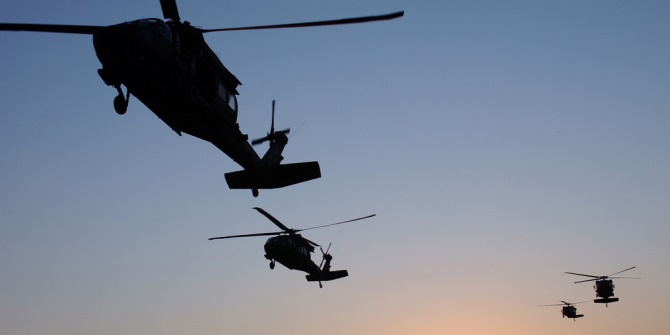 British defence and security policy has recently come under attack for lacking strategic vision. In a historical study of British strategy-making, Gwyn Prins pulls out key lessons for current defence strategists, finding that it is often best to leave the Treasury out of strategy-making.
British defence and security policy has recently come under attack for lacking strategic vision. In a historical study of British strategy-making, Gwyn Prins pulls out key lessons for current defence strategists, finding that it is often best to leave the Treasury out of strategy-making.
The October 2010, the Public Administration Select Committee inquiry into how strategy-making is conducted in the British government came to a remarkable finding. It concluded that no-one ‘does’ strategy. The August 2011 Defence Select Committee inquiry into the 2010 Strategic Defence and Security Review (SDSR) and the National Security Strategy (NSS) criticised the SDSR in conception and consequence; it declined to accept the prime minister’s view of its effects, or views similar to MrCameron’s in testimony from certain other politicians and senior officials. Neither committee thinks that Britain has a robust national security strategy today. Neither committee thinks that this problem can be fixed by marginal adjustment. They believe that the international departments of state have poor maps and compasses with which to plot their detailed courses and dispositions.
The fiduciary authority of select committees on behalf of the public interest is above that of ministers who must answer to them for their actions. It is not voluntary for the government to attend to the committees’ concerns on the committees’ terms. It is mandatory. Today’s governing class seems to feel no shame about its ignorance of history, nor does it seem aware of how risky that ignorance can be. The culture of Whitehall is notable for the absence of corporate memory and for the constant, churning turnover of people in posts. Together these characteristics mean that those who forget their history are indeed condemned to repeat it.
Origins of central strategy-making in war
British defence reorganizations have a long history. The second Boer prompted fundamental changes in the relationship between the military and the government. Future Prime Minister A J Balfour established the Committee of Imperial Defence (CID) in 1904 to prevent the ad-hoc strategic thinking, complacency and incompetence that preceded the war.
The CID had an advisory and warning, not an executive, role, and its membership embraced the service chiefs, ministers and officials. But it had wide latitude to commission and to engage external experts, rather like its successor in function, the National Security Council, or the modern select committee structure of the House of Commons. The CID was supported by a small and skillful civil service secretariat which for was regarded as the ‘keystone of the whole edifice’.
The 2010 National Security Council that Prime Minister Cameron introduced has many of the same stated objectives as the CID but expressed in today’s language. The idioms and political contexts may change but the problem remains the same. The stated purpose of the CID in 1904 was to obtain and co-ordinate ‘for the use of the Cabinet all the information and expert advice required for the shaping of National policy in war and for determining the necessary preparations in peace’. The purpose of the 2010 National Security Council is not different although, by report, its manner of conducting its business is.
Military spending in austerity
The most important test of the CID system came between 1932 and 1935. In 1932 it had protested against the Ten Year Rule, which meant that the country was calculating on no war before 1942. The Ten Year Rule was used to justify ‘taking a gap’ in capabilities in the language of the 2010 defence review, which was likewise underpinned by a Ten Year Rule logic. The Chiefs’ reply reminded the Treasury that whereas it appeared to view ‘war as a luxury which we cannot afford’, the services took the view that ‘actually it is a financial disaster we cannot risk’. Contrary to the Treasury’s impression, the fighting services were not raring to go to war but saw themselves as ‘the premium which we pay for security from war and financial ruin’.
In 1932, the Chiefs protested that it was impossible to see three, let alone ten, years ahead. In the famous House of Lords debate of 12 November 2010, whose historic importance is already widely attested, Admiral Lord Boyce (formerly First Sea Lord and Chief of the Defence Staff, 2001–03) repeated the CID’s exchange with the Treasury almost verbatim, but in different military currency:
‘the underlying rationale in the [SDSR] review for disposing of this aircraft [the Harrier GR9], which gives the carrier its strike capability until the introduction of the Joint Strike Fighter, is this: In the short term, there are few circumstances we can envisage where the ability to deploy airpower from the sea will be essential.What a desperate expression of hope over bitter experience. The people serving on the National Security Council must have been asleep for the past dozen years or so. We have no problem today because we have no emerging crisis. That can change in days’.
And so it did. Seven different crises with potential military dimensions for Britain (Korea, Egypt, Tunisia, Bahrain, Libya, Yemen, stand-by support for the civil power in the English riots) can be counted between Lord Boyce’s speech and now. Six of them have maritime aspects.
In 1932, the secretary of the CID, Maurice Hankey wrote a short appendix to the CID report giving illustrations of ‘the difficulties of forecasting peace’. He started with Queen Elizabeth laying up her fleet five months before the Spanish Armada set sail in 1588 and ended with Milner’s 1917 memorandum from Russia reporting ‘a great deal of exaggeration in the talk of revolution’.
Though the effect of the 1932 report was that the Ten Year Rule was suspended by the Cabinet, new money was not to be expected or to be forthcoming. Therefore in 1933, the chiefs, now under the chairmanship of Lord Chatfield, and supported by the Foreign Office, described in even stronger terms the mismatch between the grand strategic environment as they saw it and the state of national defence.
An implied threat that the defence forces ‘could not, with the arms we had, accept our present responsibilities as they were laid down‘ won Chatfield traction in the CID which led to the establishment of a special Defence Requirements Sub-Committee (DRSC) to review the entire strategic scene while ‘taking due regard to the financial position of the country’. The review frightened parliamentary and public opinion, but the urgency of the financial dangers was again pressed and only moderate increases in funds were proposed.
The chiefs refused to accept this settlement. Therefore, with more strategic shocks occurring, a second Defence Requirements Sub-Committee sat in July 1935. Unusually, it was given altered terms of reference to assess and to prescribe force requirements without regard to financial considerations. Mrs Thatcher employed a similar logic when shaping cabinet procedures for the Falklands war.
Coincidental with this review work, the Abyssinian crisis broke in May 1935 and revealed the hollowness of collective security. Britain was left carrying most of the military load. There are parallels in the international diplomacy leading to UNSCR 1973 in April 2011 and in the conduct of military operations arising. No sooner had Abyssinia subsided than the next unforeseen strategic shock, the Spanish Civil War, occurred in 1936. Chatfield wrote, in words which have a contemporary ring, that:
Time after time the Services were told that the financial dangers to the country were greater than the military ones. So long had the Treasury remained the real factor in the Government, in deciding what our armed strength was to be, that other influences only slowly became effective. The Government seemed unable to face the fact that every million spent now reduced the chance of war, and that if war came it would not be spent in time, while the cost would be much greater.
Following the second DRSC report, the chiefs did successfully begin to translate their grand strategic appreciation into operational strategy, via what under their influence had now become government policy.
The cardinal principle of the post-war period: collaboration
The first post-war reorganization of the British defence forces emphasised that ‘it should be the men responsible in the Service departments for carrying out the approved policy who are brought together in the central machine to formulate it’. This cardinal principle should again be the backbone which both forms and articulates the bureaucratic skeleton of the MoD. It is especially vital because it restores lines of accountability: to the service chiefs for designing force structure; to the permanent secretary for managing the money; and to the Chief of the Defence Staff for delivering military success. The motto for this relationship is ‘collaboration, not primacy’.
There is an inherent tendency for the size of the administrative civil service to grow in the MoD as more generally across government. But civil servants are not just a source of bloat and an impediment to clarity, although they often have been so. In the final analysis, the civil servant performs an indispensible duty. Recently, for example, the Ministry of Defence’s Permanent Secretary Sir Michael Quinlan effectively shaped the department’s intellectual engagement with the general public on nuclear matters at a time of high public agitation. Collaboration, not primacy, has made for success. Its value is reflected in a trend to introduce non-executives into civil service boards of management.
Past successes key to future innovations
As the June 2011 Levene Report correctly observes, ‘the success or failure of any model depends on the people within the organisation – and particularly its leaders’. The history of the CID proposes an elegant and specific recommendation that could help remedy the key defect identified by the select committee reports of 2010 and 2011: the failure of the current national security strategy methodologies to effect a reliable and credible introduction of grand and operational strategic insights into ministerial policy-making, thus leaving the Ministry of Defence without secure guidelines for deployment of its improved and reformed structure, however good it may be.
Looking ahead, there is unique value in a combined grand and operational strategic study which is militarily literate and conducted independently, without fear or favour to any party or to any transient issue and without reference to finance, leading to force structure recommendations. Only when the study is complete should financial considerations be introduced. Doubtless, the Treasury would resent and resist this now as it did in the past. But as then, so now, it is important that this opposition is overcome.
At the point when money is brought into the discussion, the government of the day would be forced to face – and be unable to avoid – an informed understanding of what it could not do because it chose not to fund the capability or, alternatively, had to do and therefore had to fund the capability. This understanding would help to balance departmental power within the Cabinet. It would thereby permit the Cabinet to inform more fully the inevitable choices about allocation of taxpayers’ money. Crucially, it might thereby provide some slim buffer against being driven uncontrollably by events.
This is the way in which to address the deficiency specifically identified by the Chief of the Defence Staff in evidence to the Defence Select Committee: to bring ‘ways and means’ into correct alignment with ‘ends’. That is what is required for – and of – a safe national security strategy.
Please read our comments policy before posting.
This article is an abridged version of the report, The British Way of Strategy-Making: Vital Lessons For Our Times, published by the Royal United Services Institute in October 2011.





